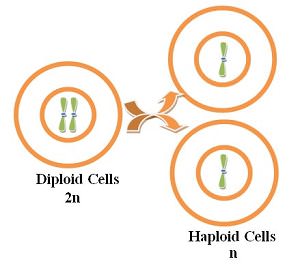We have already studied that every species has a fixed number of chromosomes. And these chromosomes occur in pairs. This means that there are two chromosomes of each kind, or we can say that there are two sets of chromosomes. Thus a cell in which chromosomes occur in pairs or in two sets of each kind is called a diploid cell. For example, the skin cells of humans are diploid because these contain 2 sets of 23 chromosomes each, thus forming a total of 46 chromosomes. Out of these two sets one set of 23 chromosomes comes from the father and other set of 23 chromosomes comes from the mother. The diploid cells are represented by the formula 2n, where n represents the number of sets of chromosomes.

A cell in which only one set of chromosomes is present is called haploid cells. In other words, these cells contain half number of chromosomes with one of each kind. For example, both the gametes (sperm and egg) of human beings are haploid cells because they have only 23 chromosomes. The haploid cells are represented by 1n of simply n.
Test Your Understanding and Answer These Questions:
- What are diploid cells and haploid cells?
- How are diploid cells represented?
- How are haploid cells represented?
